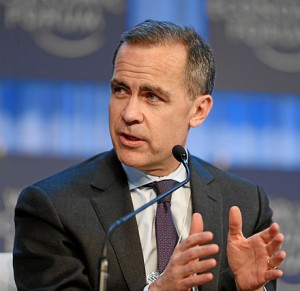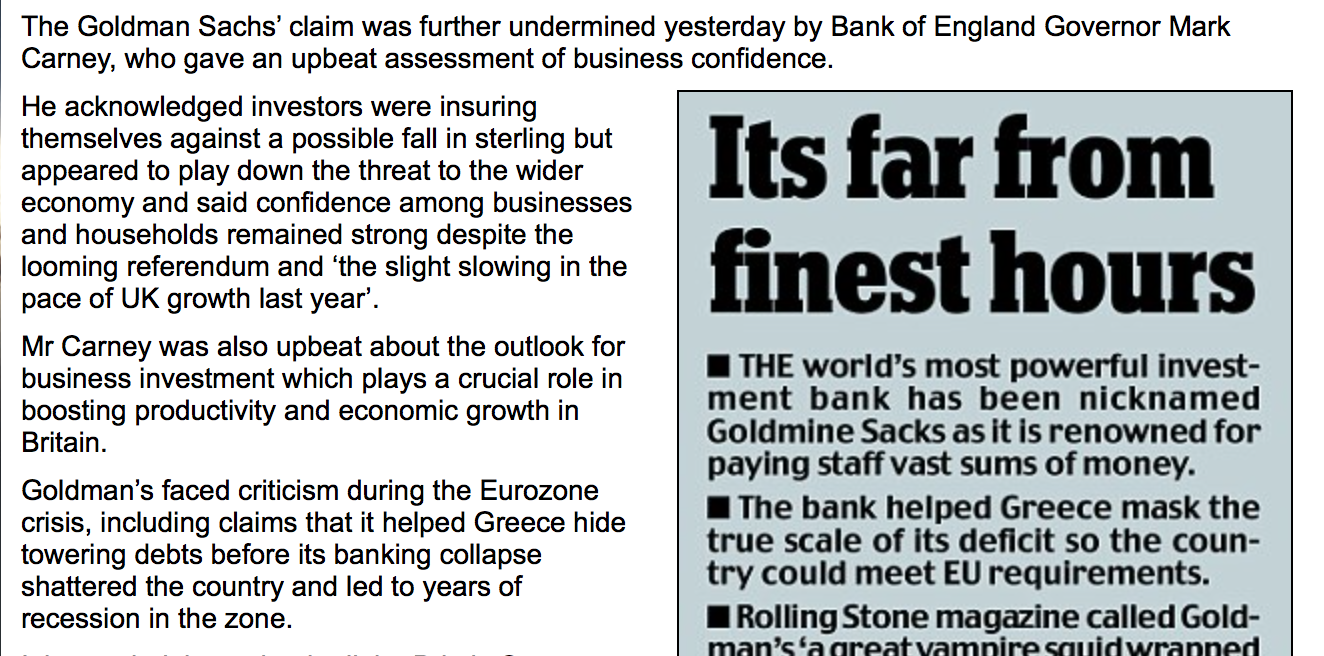Central Bank Governors Are Liars

Central Banks are complicit in the manipulation of financial markets including stock markets, commodities, gold and currency markets, not to mention the oil and energy markets which have been the object of a carefully engineered “pump and dump” speculative onslaught.
Who controls the central banks? Monetary policy does not serve the public interest.
The article below by Washington Blog quotes three influential central bankers: Mark Carney, Meryl King and Alan Greenspan.
 The current governor of the Bank of England Mark Carney (image right) is a former Goldman Sachs official.
The current governor of the Bank of England Mark Carney (image right) is a former Goldman Sachs official.
He went from Goldman to heading the Bank of Canada before being appointed Governor of the Bank of England.
At the time of his appointment he was not a citizen of the United Kingdom. A precedent was set: Mark Carney was the first foreigner to occupy that position since the founding of the Governor and Company of the Bank of England in 1694.
The issue was barely mentioned by the British media.
While Carney was appointed by Her Majesty, unofficially, he still has “links” to Goldman Sachs.
Is he in conflict of interest in relation to Goldman Sachs’ recent insinuations regarding the stability of the British Pound Sterling were the UK decide to exit the EU?
Insinuations of this nature combined with inside information are the basis for large scale speculative operations:
Daily Mail, February 2, 2016
Was Goldman Sachs’ claim really undermined by Bank of England Mark Carney as suggested by the British media? (See above) Carney served 13 years for Goldman Sachs.
Alan Greenspan, quoted below, largely served Wall Street. Lest we forget The Federal Reserve is a private banking institution.
The abstract views provided by Mark Carney, Mervyn King and Alan Greenspan focus on weaknesses of the real economy. What they fail to mention is that market manipulation and financial fraud –which are now an integral part of neoliberalism– are largely responsible for the crisis of the real economy.
In this regard, central banks share a large burden of responsibility in creating a “regulatory” environment which favors the “institutional speculators”.
Real economy explanations presented by Carney et al are in many regards misleading.
The price of crude oil did not collapse as a result of supply and demand considerations. The price of crude was pushed up and then pushed down through a carefully designed speculative undertaking involving Wall Street and the Anglo-american Oil conglomerates. The impacts of this instability in oil prices on the real economy are devastating.
Michel Chossudovsky, March 4, 2015
* * *
Central Bankers Admit that Central Banks Have Failed to Fix the Economy.
by Washington’s Blog
March 2016
Between 2008 and 2015, central banks pretended that they had fixed the economy.
In 2016, they’re starting to admit that they haven’t fixed much of anything.
The current head of the Bank of England (Mark Carney) said last week:
The global economy risks becoming trapped in a low growth, low inflation, low interest rate equilibrium. For the past seven years, growth has serially disappointed—sometimes spectacularly, as in the depths of the global financial and euro crises; more often than not grindingly as past debts weigh on activity ….
This underperformance is principally the product of weaker potential supply growth in virtually all G20 economies. It is a reminder that demand stimulus on its own can do little to counteract longer-term forces of demographic change [background] and productivity growth.
***
In most advanced economies, difficult structural reforms have been deferred [true, indeed]. In parallel, in a number of emerging market economies, the post-crisis period was marked by credit booms reinforced by foreign capital inflows [including from central banks themselves], which are now brutally reversing….
Since 2007, global nominal GDP growth (in dollars) has been cut in half from over 8% to 4% last year, thereby compounding the challenges of private and public deleveraging ….
Renewed appreciation of the weak global outlook appears to have been the underlying cause of recent market turbulence. The latest freefall in commodity prices – though largely the product of actual and potential supply increases – has reinforced concerns about the sluggishness of global demand.
***
Necessary changes in the stance of monetary policy removed the complacent assumption that “all bad news is good news” (because it brought renewed stimulus) that many felt underpinned markets [Zero Hedge nailed it].
***
As a consequence of these developments, investors are now re-considering whether the past seven years have been well spent. Has exceptional monetary policy merely bridged two low-growth equilibria? Or, even worse, has it been a pier, leaving the global economy facing a global liquidity trap? Can more time be purchased? If so, at what cost and, most importantly, how would that time be best spent?
***
Despite a recent recovery, equity markets are still down materially since the start of the year. Volatility has spilled over into corporate bond markets with US high-yield spreads at levels last seen during the euro-area crisis. The default rate implied by the US high-yield CDX index is more than double its long-run average [background here and here]. And sterling and US dollar investment grade corporate bond spreads are more than 75bp higher over the past year.
Similarly, the former head of the Bank of England (Mervyn King) is predicting catastrophe:
Unless we go back to the underlying causes [of the 2008 crash] we will never understand what happened and will be unable to prevent a repetition and help our economies truly recover.
***
The world economy today seems incapable of restoring the prosperity we took for granted before the crisis.
***
Further turbulence in the world economy, and quite possibly another crisis, are to be expected.
***
Since the end of the immediate banking crisis in 2009, recovery has been anaemic at best. By late 2015, the world recovery had been slower than predicted by policymakers, and central banks had postponed the inevitable rise in interest rates for longer than had seemed either possible or likely.
There was a continuing shortfall of demand and output from their pre-crisis trend path of close to 15pc. Stagnation – in the sense of output remaining persistently below its previously anticipated path – had once again become synonymous with the word capitalism. Lost output and employment of such magnitude has revealed the true cost of the crisis and shaken confidence in our understanding of how economies behave [Correctomundo].
***
Almost every financial crisis starts with the belief that the provision of more liquidity is the answer, only for time to reveal that beneath the surface are genuine problems of solvency [We told you].
A reluctance to admit that the issue is solvency rather than liquidity – even if the provision of liquidity is part of a bridge to the right solution – lay at the heart of Japan’s slow response to its problems after the asset price bubble burst in the late 1980s, different countries’ responses to the banking collapse in 2008, and the continuing woes of the euro area.
Over the past two decades, successive American administrations dealt with the many financial crises around the world by acting on the assumption that the best way to restore market confidence was to provide liquidity – and lots of it.
Political pressures will always favour the provision of liquidity; lasting solutions require a willingness to tackle the solvency issues.
Former Federal Reserve chairman Alan Greenspan said today that the Dodd-Frank financial bill didn’t fix anything [d’oh!], that we’re in real trouble, and that he’s been pessimistic for a long time:
We’re in trouble basically because productivity is dead in the water…Real capital investment is way below average. Why? Because business people are very uncertain about the future.
***
The [Dodd-Frank] regulations are supposed to be making changes of addressing the problems that existed in 2008 or leading up to 2008. It’s not doing that. “Too Big to Fail” is a critical issue back then, and now. And, there is nothing in Dodd-Frank which actually addresses this issue.
***
I haven’t been [optimistic on the economy] for quite a while.
And the world’s most prestigious financial agency – called the “Central Banks’ Central Bank” (the Bank for International Settlements, or BIS) – has consistently slammed the Fed and other central banks for doing the wrong things and failing to stabilize the economy.
If the central bankers’ words aren’t clear enough for you, their actions reveal their desperation.



